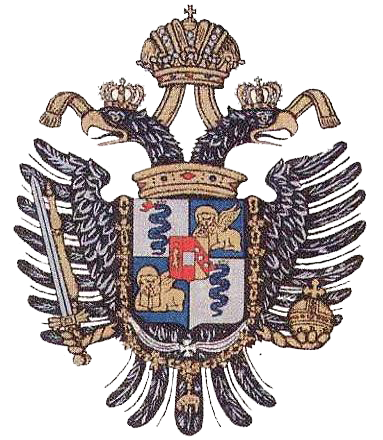Forged stamps of Lombardy & Venetia
Lombardo-Veneto
Lombardo-Veneto
Coat of Arms
 The first five stamp values issued by Lombardy-Venetia (Italian: Regno Lombardo Veneto) share a common origin with its twin Austrian issue. The first issue maintained a provisional nature during its life: several changes were make to stereotypes, experimental usage of different paper types were common.
The first five stamp values issued by Lombardy-Venetia (Italian: Regno Lombardo Veneto) share a common origin with its twin Austrian issue. The first issue maintained a provisional nature during its life: several changes were make to stereotypes, experimental usage of different paper types were common.
Typographically printed, at the beginning on hand made paper with central watermark KKHM (Kaiserlich und Koenigliches Handels Ministerium), every sheet were made of 256 stamps (including 16 Andreas crosses), and was unperforated. Colours appeared in various shades during its eight years.
The subject portrayed (slightly different from the essays) on the stamps was the Two-headed Habsburg Eagle, surrounded by a shield with floral decorations (branches, leaves, acorns) with the Austrian coat of Arms on the chest. Above the shield a crown divided the stamps description: KK POST Stempel (Royal Imperial Post stamps). A lower frame surrounded the value of the stamps.
The value frame is the only noticeable difference between the Austrian and Lombardy-Venetia stamps. The Austrian stamps were issued in the Florin currency, The Lombardy-Venetia counterparts in Centesimi.
Stereotypes had the same subject (with slightly differences as we are going to analyse) but the value frame and the digits were not removable, so it was not possible to use the same stereotypes for different denominations by simply changing the digits. A clear example is the position of “S” in “Centes”: On the 5 Centes, it is left to the upper reversed v frame. On the 10 Centes, it is aligned but not linked to the v ornament. On the 30 & 45 Centes, it is both aligned and linked.
Each of the 5 stamps has its own features that allow to divide the stamps in different types and subtypes. This is due to changes made to correct bad looking defects (i.e. the changes for 10 Centes type I to type III). The ongoing evolution and the continuous changes did not only happen to the stereotypes, but also paper and ink shades. Different experiment were made with paper (slighty-vergé and vergé paper) and the last plates were made on cheaper machine-made paper.
Official reprints were made by the Vienna Postal Authorities due to the great demand by collectors for philatelic purposes. Only Type III, on machine made paper without watermark were officially reprinted.
Forgeries exist as well. Postal forgeries of that period appeared in 1853 and 1857-1858. These are known as Milano or Verona Forgeries.
Philatelic forgeries were made later on, the most famous ones being Fournier’s. lithographically printed and usually a little taller than the original ones (genuine stamps measure 21 mm). Pay attention to forgeries printed on original hand made paper (chemically cancelled before the forged printing process) or similar looking paper.
Emperor Franz Joseph
The second issue of Lombardo Veneto was introduced on November the 1st, 1858; valid until May 31st, 1864. Like the previous issue, the design is identical to Austrian stamps. The only difference is the value description: KR. (Kreuzer) for Austrian and Soldi for the Italian. The subject was emperor Franz Joseph’s portrait, looking left, wearing a bay leaves crown. Each value had the Emperor’s portrait embossed, surrounded by different geometrical or floral themes changing for each one of the five stamps. They were printed on machine-made paper sheets of 256 stamps (including 16 St. Andrew Crosses), perforated either comb 14.5 x 14.5 or line 15, 15.5 or 16.
There are two types of these stamps. The main difference being the portrait of the emperor: the knot of the crown is open, resembling a “3”, the top bay leaves are not sharp and not defined. The nose and mouth also look different compared to Type II. Type II has a complete knot and 3 well defined tips.
There are no known forgeries of the 1858-1862 issues. Howeever, official reprints exists. Only type II exist as reprints. The paper and perforation are different from the originals. Pre-paid envelopes of 1861-1862 were also reprinted. They can be recognized by the linked strips of the knot.
Watch out for forged postmarks. Use the historical events as guideline: Habsburg lost Lumbardy (except Mantua and few other towns of that district) during the 1859 war against France and Sardinia. If the stamp were issued after 1859 like the 3 Soldi green, and it bear a Lombard post office postmark, it is a forged postmark. Any postmarked reprints are also obvious forgeries.
Thanks to Gabriele Cafulli-Cassaghi for genuine vs. forgery analysis
Recommended resources
Know any relevant websites? Please contact me!
For further research
